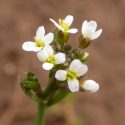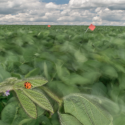Evolution’s hand detailed in Hawaiian lobeliads
Because of its great isolation from the rest of the world, the Hawaiian archipelago and its unique array of plants and animals has always been of keen interest to evolutionary biologists.
Now, the islands have given up another tantalizing peek into evolutionary history as a team of botanists using the latest molecular techniques has traced the origin of the islands’ spectacular array of 125 species of lobeliads to a single colonization event some 13 million years ago.
Slide show
This is a slide show story that requires the Flash 8 or higher player plugin. Download and install it.
Writing online today (Oct. 16) in the Proceedings of the Royal Society B, a team led by University of Wisconsin–Madison botanists Thomas Givnish and Kenneth Sytsma details the evolutionary history of a diverse tropical group of flowering plants long viewed as one of the plant world’s most dramatic examples of adaptive radiation, the phenomenon of new species arising from a single ancestor to occupy a multitude of ecological roles. Adaptive radiation is an important process bridging ecology and evolution and is particularly common on islands, where few plants or animals arrive naturally, and where there is often strong pressure for closely related descendants of a colonist to diverge from each other to reduce competition.
The Hawaiian lobeliads — relatives of the familiar cardinal flower and other showy herbs — make up one-eighth of all of Hawaii’s native plant species and occupy virtually all moist habitats on the islands, from the sides of towering sea cliffs to rain forests, scrub, and mountain bogs. They take numerous forms. Most are trees or shrubs, but some are vine-like, live as epiphytes on the branches of other woody plants, or are succulent plants. The majority are pollinated by birds, but a few are visited by hawk moths. Several groups have wind-dispersed seeds, like most mainland lobeliads, but many have fleshy, berry-like fruits. This diversity has made the origin of the Hawaiian lobeliads a contentious issue, with scientists proposing as many as five colonization events from areas as far away as Africa, South America and Australia.
“Our DNA sequence data, calibrated independently against the ages of mainland fossils and the ages of islands to which today’s species are restricted, indicate the lobeliads arrived in the Hawaiian island chain 13 million to 13.6 million years ago,” according to Givnish, a UW–Madison professor of botany. “All the groups in Hawaii are descended from a single common ancestor and it appears they arrived on the islands long before any of the current islands emerged from the sea starting five million years ago.”
Lobeliads, according to Givnish, most likely arrived in Hawaii as dust-sized seeds sailed through the atmosphere from a distant tropical mountain and, beating the odds, settled on similar habitat in Hawaii, the world’s most isolated island archipelago. Gardner Island, now a speck of volcanic rock in the northwestern Hawaiian Islands but once the largest and tallest of the Hawaiian Islands in the last 40 million years, was probably where the ancestral lobeliad settled some 13 million years ago, according to the new study.
“We think Gardner would have been an ideal place for lobeliads to colonize,” Givnish explains. “It had a full range of moist habitats, remained above sea level for a long time and provided a platform from which lobeliads could have dispersed down the island chain to today’s islands.”
Once established, lobeliads first diverged into six major lineages adapted to forest edges, forest interiors, scrub, bogs, sea cliffs, and interior rock walls. Subsequently, the largest genus Cyanea — adapted to rain-forest understories and canopies — diversified repeatedly on each island into similarly diverse, similarly divergent arrays of species.
Based on the similar size of these Cyanea radiations on all islands except the youngest (Hawaii, the “Big Island”), Givnish and his colleagues conclude that the process of speciation and ecological diversification in this tropical group saturates an environment in less than 1.5 million years.
“This is a remarkably short period, and it casts important new light on the tempo of plant evolution and the assembly of tropical plant communities,” Givnish notes. “The fact that we now know that the Hawaiian lobeliads are also the biggest plant radiation on any single archipelago makes them especially important to any discussion of the genesis of biological diversity.”
Today, many of Hawaii’s lobeliads are threatened, and several have gone extinct. Some have lost their pollinators, primarily birds and moths, and must be pollinated by human hand to survive. Many species are now restricted to cliffs or remote ridges, where the rugged topography protects them from being eaten by pigs, goats, deer and other herbivores introduced by humans.
“The tragedy is that many species in this and other remarkable groups of Hawaiian organisms are highly susceptible to extinction,” says Givnish. “Of the 76 described species of Cyanea, 23 are extinct and 24 are endangered.”
The new study is co-authored by researchers from Florida State University; the Morton Arboretum in Lisle, Ill.; Boise State University; and the National Tropical Botanical Garden in Kalaheo, Hawaii. The study was supported by grants from the National Geographic Society and the National Science Foundation.



